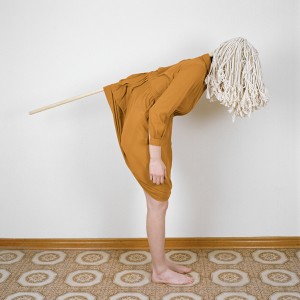Alex Kisilevich: The Camouflaged Man
Encountering the work of Alex Kisilevich is a little like spotting a Kallima butterfly for the first time. Kallima comes from the Greek word “kali,” which means beautiful, but put aside your perceptions of that last Monarch butterfly you witnessed, flitting quickly from view. The Kallima will, when drawing its wings together, perfectly resemble a dead leaf. It’s a master of camouflage, and it has a lot in common with our artist.
Kisilevich is a young Toronto native, and unlike the rest of his Ukrainian family, he was born and bred in the province of Ontario, Canada. His photographic images are some of the most exciting and jarring to be found in today’s art scene. A woman, bent in half with her head concealed by a kitchen mop; a girl whose face resembles a shock of hair as if seen from behind, but the front of her dress is facing us in the photograph; a life-size bundle of dried twigs in the form of a man, but wait — there is a man behind it all. At the beginning of our phone interview, there was shyness in his responses, perhaps not unlike the aforementioned butterfly, but his openness and enthusiasm in describing his work and its genesis soon emerged.
“I was doing a music degree at York University between 2003 to 2007, and in the middle of it, I decided to randomly enroll in photography — I needed to take some elective courses — and I really fell in love. I spent more and more time in the dark room and started skipping my own music classes,” he says.
Not wanting to entirely abandon his first involvement with music through his classical guitar playing, he obtained his BFA with honors in Music in 2007, quickly followed by a BFA with Distinction in Photography at Ontario College of Art and Design. By now, the habit of study had taken a firm hold, and back at York University, he completed his MFA in Visual Arts. It was during this final lap, that he produced a body of work for his thesis, which he calls “Kallima.”
The Kallima project, centered on the idea of camouflage in nature as well as in human behavior, was a difficult thing for Kisilevich to pinpoint in his own life. However, he admitted that it was important in referencing photography and the “baggage attached to it,” to also reference the real and the unreal, to “show truth, and yet, show it subverted at the same time.” He described a passage from his thesis on mimicry in nature, which motivates much of his own work:
“What motivates such an evolutionary development if not self-preservation? Perhaps it is a kind of sympathetic sentience, a way to connect with and find meaning in the external world, or is it perhaps the result of a gradual loss of self-identity over time, or a sense of bewilderment in relation to one’s surroundings?”
The images in his Kallima repertoire he sees as “full of pathos and absurdity,” alluding to “ideas of illusion and transparency, masking and disguise, assimilation and adaptation, as well as the ways we construct connections between ourselves and others.”
These concepts are not new ones, and many of his works seem to call upon surrealism and the power of dreams. Andre Breton, the French surrealist, and one of the founders of the early manifestations of that movement, said that he was always amazed of how there was so much more credence attached to waking events than to those in dreams. Examining several of Kisilevich’s contemporary images, one cannot help but see a profound similarity to those of René Magritte, as if he were intuitively harking back to the surrealist’s own obsessions through his interpretation between the waking life and that of dreams.
Hair Head, Kisilevich’s image of a young woman’s back of the head facing front (described earlier) and Disco Figure, showing a fragment of a mirrored disco ball instead of a face on his live model, could be incarnations from Magritte’s own surrealistic repertoire. Magritte’s philosophy, that originality lay in the revelation of affinities between otherwise conventional elements, was illustrated in such works as The Conqueror, revealing a man’s figure in evening dress with a plank of wood jutting out of his neck in place of a head.
A second pairing between the two artists is Kisilevich’s Log, where the chromogenic image of a log seems to float out of a layer of wavy fabric. Kisilevich was “revolted” by the fabric when he found it, but the suggested grains of wood in its pattern intrigued him enough to keep the cloth on his wall until he found a use for it. Another surrealist, Max Ernst, comes to mind when studying this piece. As a child, Ernst was obsessed with the rough wood of his bedroom floor and made rubbings of the grain which suggested all manner of images. His later works, such as To 100,000 Doves are exquisite examples of this process. Kisilevich, however, has drawn little on such verisimilitude in his own work.
“I had a real hole in my education in art history. Because of my advanced placement, I missed core years of studying the masters. I’m learning now for myself,” he says.
(Article continued on next page)

